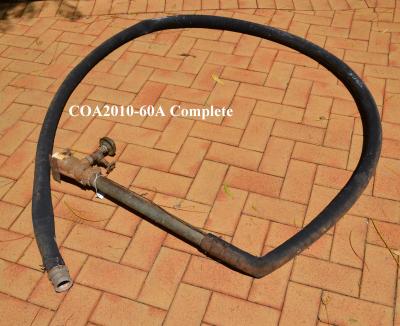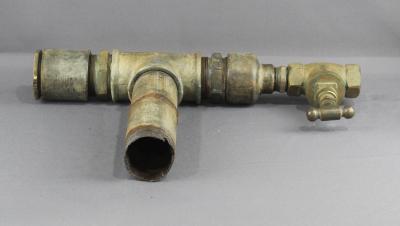CAMP BED
c. 1945 - 2010The bed frame is a flat rectangle with a slight upsweep at one end and is made from half inch galvanised water pipe. The ''U'' shaped legs are attached via welded brackets by bolts and are able to be folded flat to the base. The mattress supported by large aperture wire mesh laced onto the frame with single strand fencing wire.
This bed was issued to the Jasek family when they were living at Migrant Camp no1 on Brookton Highway Kelmscott. It was taken with them when they moved totheir new home at 182 Brookton Highway and eventualy was used as a makeshift fence in the milking shed.
The Jasek Family story by Zena Lenanton (August 2011).
Wladyslaw (Wally) Jasek 1919 - 2006. Barbara Jasek 1928 - 2009. (Previously of 182 Brookton Highway, Kelmscott). Both were born in Poland, and died in Perth, Western Australia. In 1942, at the age of 14, Barbara was forcibly taken from her family in Poland by Germans soldiers and transported to Germany, where she was required to work for the Germans during World War II. Around the same time, and due to unforeseen circumstances associated with the war, Wally also unwillingly found himself having to work in Germany as part of the Forced Labour Programme. At the time of their arrival in Germany, neither spoke the German language.
They eventually met after the war, married, and remained in Germany with their young daughter until they migrated to Australia in 1950. A second daughter was born some years after they had settled in Australia.
As a refugee family they traveled from Germany to Italy, departing from Naples on 7 February 1950 on board the S.S. Fairsea. They arrived in Fremantle (Western Australia) on 2 March 1950, unable to speak the English language and with only a suitcase between them. They were among the thousands of refugees that came to Australia as part of the Australian Government Massive Migration Program.From the Port of Fremantle, they traveled by train in the extreme summer heat (110° F) to the ex-Army Barracks in Northam. Bush fires that were raging along the rail route had many families questioning their decision to migrate to Australia. Was this really a place of milk and honey, or yet another place of devastation?Barbara insisted that the family not be separated, even if the living conditions were primitive. I would prefer to live in a tent, rather than be separated from my family again. The fear of isolation, and the family being torn apart had already been experienced by her in Poland 8 years earlier at the age of 14, and she did not want to experience this again.
The men were contracted to work for 2 years in locations nominated by the government- there was no choice in the matter. Kelmscott was one of these destinations. Several months later, the family was re-located from Northam, arriving by train in Kelmscott. They were re-settled in the Displaced PersonsMigrant Campon River Road (now Brookton Highway) Kelmscott, with more that 40 other migrant families. The men were assigned to the Metropolitan Water Supply Department to work on a range of projects in the area e.g. upgrading the pipe link between the Canning Dam and the reservoirs in Perth, and later in the 1950s, on the construction of the Serpentine Dam.Many of the families stayed in the Camp for some years, as rental propertiesin Perth were very difficult to acquire (particularly if you had children). Families saved their money so as to acquire a place of their own, or a block of land upon which they themselves could eventually build their own home.In the Camp, one of the Nissen Huts was set aside to be used as a Catholic Church. It was also used as a Polish school for the children, and as a meeting place for the Polish community. The preservation of aspects of the Polish culture was given high priority.
Over the road from the Migrant Camp was a desirable4 acre property that extended down to the Canning River. Children from the Campgot to know the property as they walked down Bernard Street, across the foot-bridge over the Canning River, on their way to and from school. Some of the young boys from the Campsoon found themselves helping the owner of the River Road property (now 182 Brookton Highway) with the picking of fruit, fixing the fences, milking the cows etc. On weekends, the river was a hive of activity. Marron, gilgies, and cobblers were often caught, and in the summer months, the children taught themselves to swim. On other occasions, the children accompanied their fathers and older brothers on excursions up into the hills of Mt Nasura to catch rabbits. Traps were set and ferrets were often used to chase the rabbits out of their burrows. During the winter months, the hills also provided a good source of mushrooms.
Wally and Barbara wondered if they could ever own such a property. A lot of hard work would be required, but it had huge potential. The existing, partially renovated brick and iron home needed to be completed, in order to replace the original, mud-brickhome, that had been built by the early settlers and which was now somewhat old and damaged. A recent fire had also devastated parts of the property, destroying fences, and most of the orchard. However a section of the land had previously been leveled in preparation for the construction of a tennis court, and this was the key factor that eventually persuaded Wally to purchase.
The property would enable them to own a plot of landgiving them independence and freedom. It would also provide them with a healthy lifestyle and would enable them to become self-sufficient.
The opportunity to purchase arose in 1958 when the property came up for sale and the family put in a successfuloffer. Shortly afterwards, they packed their belongings and walked across River Road down the long driveway to their new home. The solitary white gum which is in the top corner of the paddock (and is now such a landmark) has grown prolifically over the 50 years, and is now surrounded by a great number of other self -sown saplings.
Life was full of hope, hardship, and improvisation. But the land was an asset and they could visualise living on this land. This new lifestyle was a steep learning curve, as neither of them had any prior experience of farming. They would talk to their friends and neighbours, glean relevant bits of information from the W.A. Agriculture Department, and read avidly from a great number of sources. (Many of the books they used were even being sent by relatives in Poland).
The priorities were put into place - rebuild and fix all the fences, buy a cow, plant some fruit trees and grow some vegetables.The cow would help keep the pasture down and provide milk in order to make butter and cheese. The surplus milk and cream could be passed onto friends and neighbours.Milking sessions were very difficult, as there was no milking shed. Frequently the cow would be milked in the pouring rain, with Barbara sitting on a flimsy stool. A temporary shelter containing a very rudimentary cow crushwas built. Some food was placed in a container on the ground, in order to lure the cow in to be milked. A rope was looped around the neck of the cow, and this was then attached to a stake. There were numerous events where the cow would show its displeasure by flicking its tail across Barbaras face, and at times flinging its foot out, and knocking over the bucket of milk.
These difficult and unpredictable events provoked some action. Shortly afterwards, with the help of a Polish friend (who had actually lived on a farm in Poland before the war, and had worked with cattle), a very simple, but a far more functional cow crushwas constructed within a larger shed on the property. The cow could now be contained more securely within the crushwhilst being milked. This cow crushhas now been donated to the Armadale Museum. Although its design dates back to much earlier times, it was constructed on the farm in the late 1950s, using a design which had been used in Poland, well and truly before World War II.Sammy, the first cow that they bought, had been raised as part of a herd. When she heard the bellowing of cattle in the distance in the region of Mt Nasura, she would, on many occasions, break through the fence and race up the hill at full speed to a neighbouring farm where a herd of cattle of similar appearance was located. It always caused a great deal of consternation locating, identifying and ultimately leading the cow back home along River Rd, with cars, trucks and buses whizzing by.Over the years several other milking cows were acquired and many calves were raised and then sold.
The family soon acquired some birds, a pair of chickens, ducks, geese and turkeys and within a relatively short period of time, these multiplied into large flocks i.e. up to a hundred turkeys at one stage. Consequently, for quite a number of years the staple diet of the family was roast turkeylambs, and piglets were also raised, but the family ultimately decided to keep a horse which helped keep the grass low. Each new experience had its own set of challenges.
A few fruit trees of each variety were now also planted to help make the family self-sufficient. Citrus fruit grew prolifically in the rich loamy soils of the Brookton Valley, and the subsistence orchard was soon expanded to make it more economically viable. Primarily, they chose to specialise in mandarinsand oranges, but some lemons and grapefruit, as well as some tropical fruit and a large variety of stone-fruit were also grown. Pumping rightsfor the use of the water from the Canning River had been obtained earlier, and the system was driven by an effective Stalker Pump which was installed and located at the bottom of the property on the banks of the Canning River. The reticulation was upgraded to an overhead sprinkler systemthat proved to be more effective at distributing the required water to the trees.They had to learn how to manage the orchard; from the initial selection of suitable trees, planting and raising them, watering, fertilizing, spraying for pests, and pruning. Then there was also the picking of the fruit, cleaning, packing, and marketing of the product. The orchard eventually comprised of a great number of fruit trees. A great variety of vegetables, herbs etc. were also grown This gave them great pleasure, as they had a year- round supplyof fresh fruit, vegetables, milk, meat, eggs etc and they no longer had to purchase any of these products from retail outlets.
The property was owned by the family for just over 50 years, and as the years passed, their need for self-sufficiency, and their ability to maintain this demanding lifestyle diminished. While they ceased to raise animals, they persisted with a smaller, but much more diverse orchard, which was maintained for their own needs. In latter years, Barbara put all her energies into growing a huge assortment of flowering plants and she would take great delight in taking family and friends for a tour around her extensive and colourful garden.
Details
Details
HIGH
Historic: The bed is from the Migrant Camp No1. This camp was established by the Water Supply Board to house workers and their families who had come to the Armadale-Kelmscott Region as part of the UN Refugee Resettlement Program to work on the upgrading of the pipes linking the Canning Dam to the water resevoirs in Perth. Many of these migrants were forced to leave Europe after the devestation of their homeland during WWII.
City of Armadale - History House
City of Armadale - History House
Other items from City of Armadale - History House
- HOSE, IRRIGATION HOSE - WITH SPRINKLER ATTACHMENT
- PIPE, IRRIGATION - JUNCTION SECTION
- PIPE, IRRIGATION - PLAIN THREADED
- PIPE, IRRIGATION PIPE - FITTINGS
- PIPE, IRRIGATION - TAP
- BROCHURE, SALES - ARMADALE SHOPPING CENTRAL
- RADIO-TELEPHONE, TWO-WAY
- CLAY BRICK - ARMADALE
- BOX FOR COMMODORE 64 COMPUTER
- SHEATH FOR BOX FOR COMMODORE 64 COMPUTER
- COMMODORE Plus/4 COMPUTER AND INTEGRATED KEYBOARD
- COMMODORE Plus/4 COMPUTER POWER PACK








